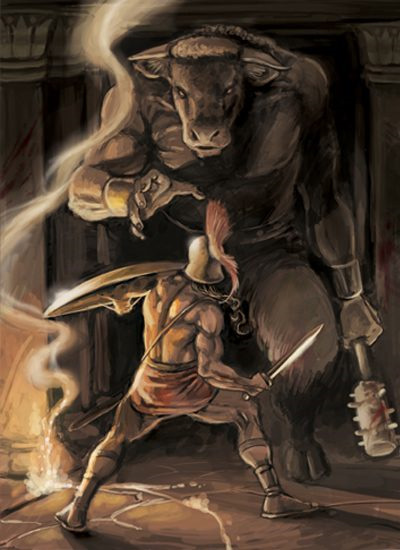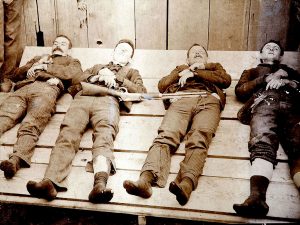Theseus was a Greek hero and was the son of Aethra, princess of Troezen, and daughter of king Troezen. His father was Aegeus, the king of Athens, though there are stories that say that Poseidon, the god of the sea, was Theseus’s father. Theseus was brought up by his grandfather and lived in Troezen, but at the age of only sixteen, he went to Athens and claimed his father, who he believed was Aegeus. Throughout the journey, Theseus killed many others; however, his greatest victory was still yet to come. He eventually encountered the Minotaur, who was a monster that was half human and half bull.1

The Minotaur was son of Pasiphae, queen of Crete and wife of King Minos of Crete. Queen Pasiphae slept with a bull, which is how the Minotaur came to be. A snow-white bull had been sent to King Minos; however, when King Minos did not sacrifice the bull to Poseidon, Poseidon caused Pasiphae to fall in love with the beautiful bull.2 The product of her love was the monstrous Minotaur. This obviously made Minos upset; however, he did not want to kill the monster. He set the architect Daedalus to create and build a labyrinth that made it impossible for anyone to get out without the help of someone else.3
In the labyrinth, the Minotaur was fed young humans, along with several of Minos’ enemies. These humans were victims of Minos, who were forcibly sent by Athens as tribute. Every year, Minos would have seven boys and seven girls sent to the labyrinth, and each year none of the several tributes would return. Once in Crete, they were devoured by the monster-like, blood-thirsty Minotaur. One day, Theseus decided that he would be the one to finally come back out of the labyrinth and end this practice. He, unlike others, volunteered himself as one of the victims. Theseus and the other several hostages sailed for Crete. When Theseus arrived in Crete, he was greeted as the doomed by several locals, and among the crowd was Ariadne, the daughter of King Minos, who immediately fell in love with Theseus and came up with a plan to help him defeat the Minotaur. She gave Theseus a ball of thread that he would fastened to the door of the maze in the labyrinth and unwind the ball until he reached the Minotaur.4

As Theseus and the other victims entered the labyrinth, the Minotaur was sleeping. He immediately took action and wasted no time in trying to defeat the creature. Theseus had absolutely no weapons, not even a sword. He fought the Minotaur hand-to-hand and succeeded, with his very own bare hands, beating the repulsive creature to death with just one blow from the fist. He then helped the other hostages who were in the labyrinth to safety, using the thread to find his way out. After defeating the Minotaur, Theseus and several other Athenians sailed back to Athens, taking along Ariadne. Though Theseus took Ariadne along with him to Athens, he eventually abandoned her on an island.5
On the way back to Athens, Theseus made a promise to his father that he would change the color of his sails if victory was his. Black meant that he had not made it back and white meant that he had; however, Theseus forgot to do so, causing his father to kill himself out of grief. When Theseus’ father died, he became the king of the city-states of Athens. He was honored for his victories and for his win over the Minotaur. He was also honored for making the kingdom larger.6
- Ancient Greece and Rome: An Encyclopedia for Students, 1998, s.v. “Theseus and the Minotaur,” Carroll Moulton. ↵
- Funk & Wagnalls New World Encyclopedia, 2016, s.v. “Minotaur.” ↵
- UXL Encyclopedia of World Mythology, 2009, s.v. “Theseus.” ↵
- The Greenhaven Encyclopedia of Greek and Roman Mythology, 2002, s.v. “Theseus in the Labyrinth,” by Don Nardo. ↵
- Ancient Greece and Rome : An Encyclopedia for Students, 1998, s.v. “Theseus and The Minotaur,” Carroll Moulton. ↵
- UXL Encyclopedia of World Mythology, 2009, s.v. “Theseus.” ↵



41 comments
Justin Martinez
Greek mythology has always interested me, but I didn’t know how the minotaur came into existence so I’m glad the author included that in the article. I find it hard to believe that Theseus could defeat a minotaur in just one blow, however I suppose anything is possible. I don’t know much about Theseus, but what if he didn’t “forget” to change the color of his sail? I mean it sounds horrible, but he did leave Ariadne on an island even though she gave him the yarn to mark his trail and find his way back out of the labyrinth.
Cristina Cabello
I find it really interesting to read about these stories, whom people used to tell. I liked how you covered a lot of details with the mythical creatures, in order to explain them thoroughly. I think it is good that you did that because maybe some people have not read any of these stories. It is really cool how creative the Greeks were with their stories. You did a great job writing this.
Belia Camarena
During high school, I learned about the legend of the minotaur and the island of Crete in my world history class. However, I did not know that the minotaur was defeated by Theseus. What shocked me the most about this story is that Theseus’ father committed suicide because Theseus forgot to change the color of his sail. As a result, his victory wasn’t a complete celebration.
Constancia Tijerina
This article really intrigued and as well as one of my deep interests to mythology. The author had really done some thorough research and the story of Theseus and his battle against the Minotaur which seemed as if Theseus had no chance at surviving a battle against that creature. However, Theseus miraculously beats the Minotaur and escapes with other victims and puts and end to this game. Overall, i believe this article did a great job at intriguing other readers into something that is so interesting, great work!
Anais Del Rio
This was an interesting article to read because it explained how the Minotaur came to be and how it ate kids who were basically sacrificed. It was crazy that Theseus defeated the Minotaur with just his bare fists, I would have expected him to have taken a spear or a shield to protect him. But even with a victory it had a sad ending of human nature forgetting to do something important and his father ended up dead.
Jason Garcia
It’s interesting to see the stories that the ancient people told. A creature of horrendous origins and how he was killed The minotaur is probably my favorite part of Greek mythology now that I know its entire story its easy to make sense of why they told these myths. I had known about the labyrinth and the Minotaur for a long time but I had no idea that it was Theseus that killed him. While I loved the story and was excited to learn how the Minotaur was killed I do think that Theseus cheated when he got help from the outside.
Timothy ODekirk
I have never heard of this story with Theseus and the minatour and found it interesting. However, I did know about King Minos and the capturing of seven victims in the labyrinth. I did find that disturbing in the story. I was also intrigued about Theseus and his courage and strength to be able to willingly offer himself as one of the victims to King Minos. In addition, I found it interesting how Theseus defeated the minatour with his bare hands, when the pictures of the event depict him with a sword and a shield. This myth was an intriguing story.
Kailan Pena
Greek mythology has always been so interesting to me so it was great to be able to read such an intriguing and well-written article about the subject. I had no idea that the minotaur was actually the child of a macabre and gross love, and I didn’t know of the story of Thesus. Great in-depth information on an interesting topic.
Didier Cadena
The story of the minotaur is one of my favorites in Greek Mythology. Mainly because of how intense the story is, Theseus defeating the Minotaur, in the infamous labyrinth, only with his hands and then returning home as a champion. I also enjoyed how tragic the story is, with Theseus leaving Ariadne behind and Theseus’ father killing himself. The article does a great job of telling the myth and making it interesting to read.
Natalia Carroll-Long
This article was intense from beginning to end. It has so much action in it from the minotaur eating Minos’ enemies to Theseus killing it. This is one of the reasons why I love mythology. It’s like sometimes it can be deep and meaningful and then other times, like this one, it’s just about heroic duties. The Greeks must of had a lot of fun writing these myths and have had a lot of times on their hands because I was intrigued.